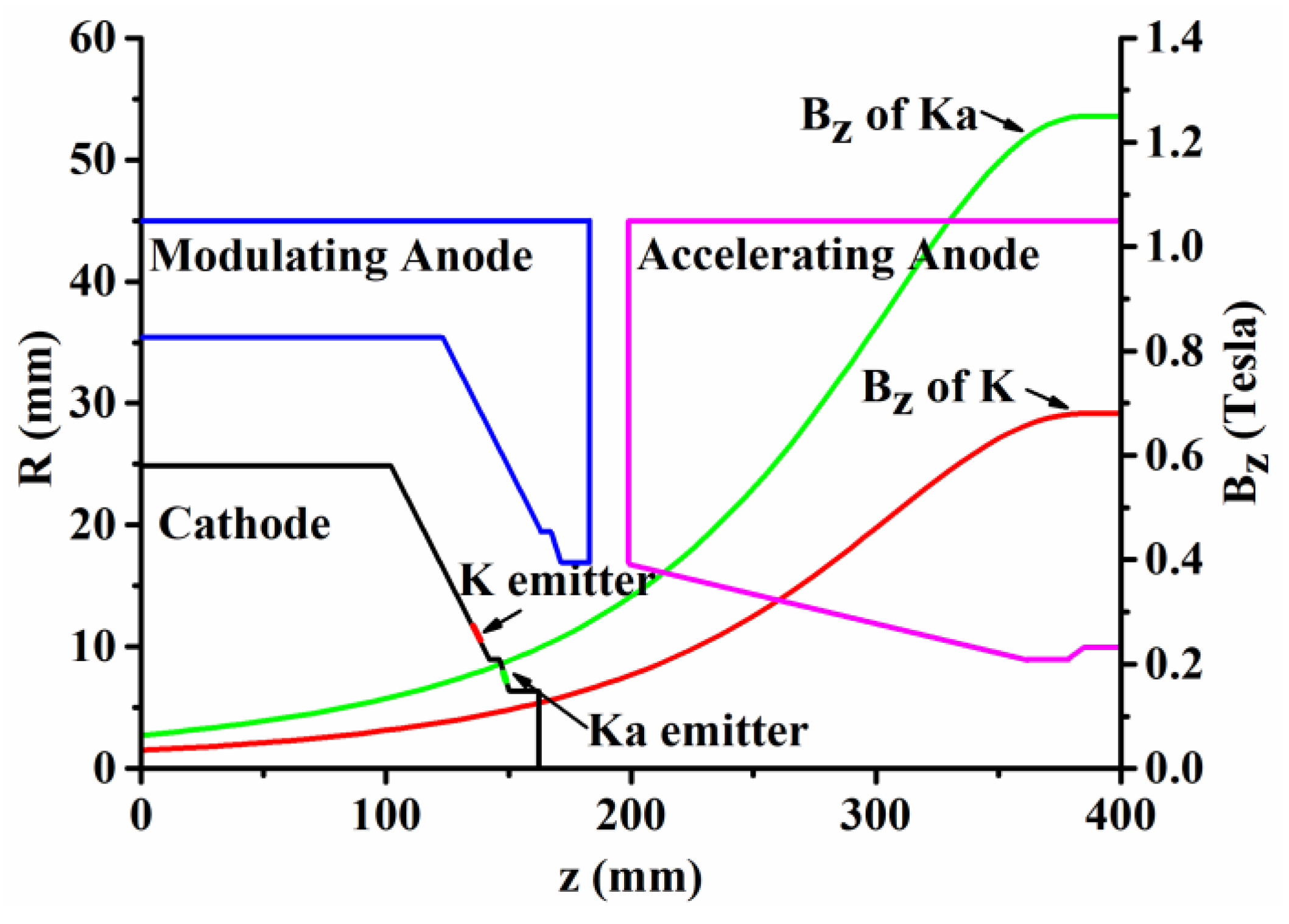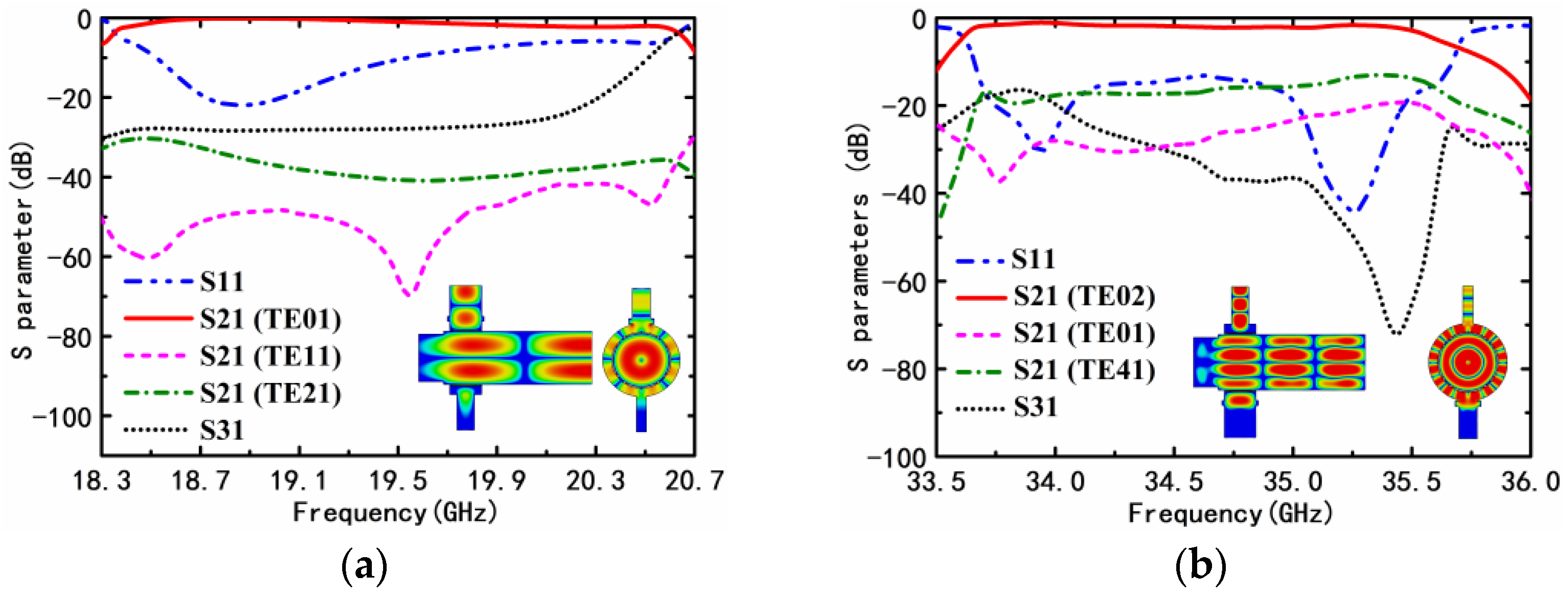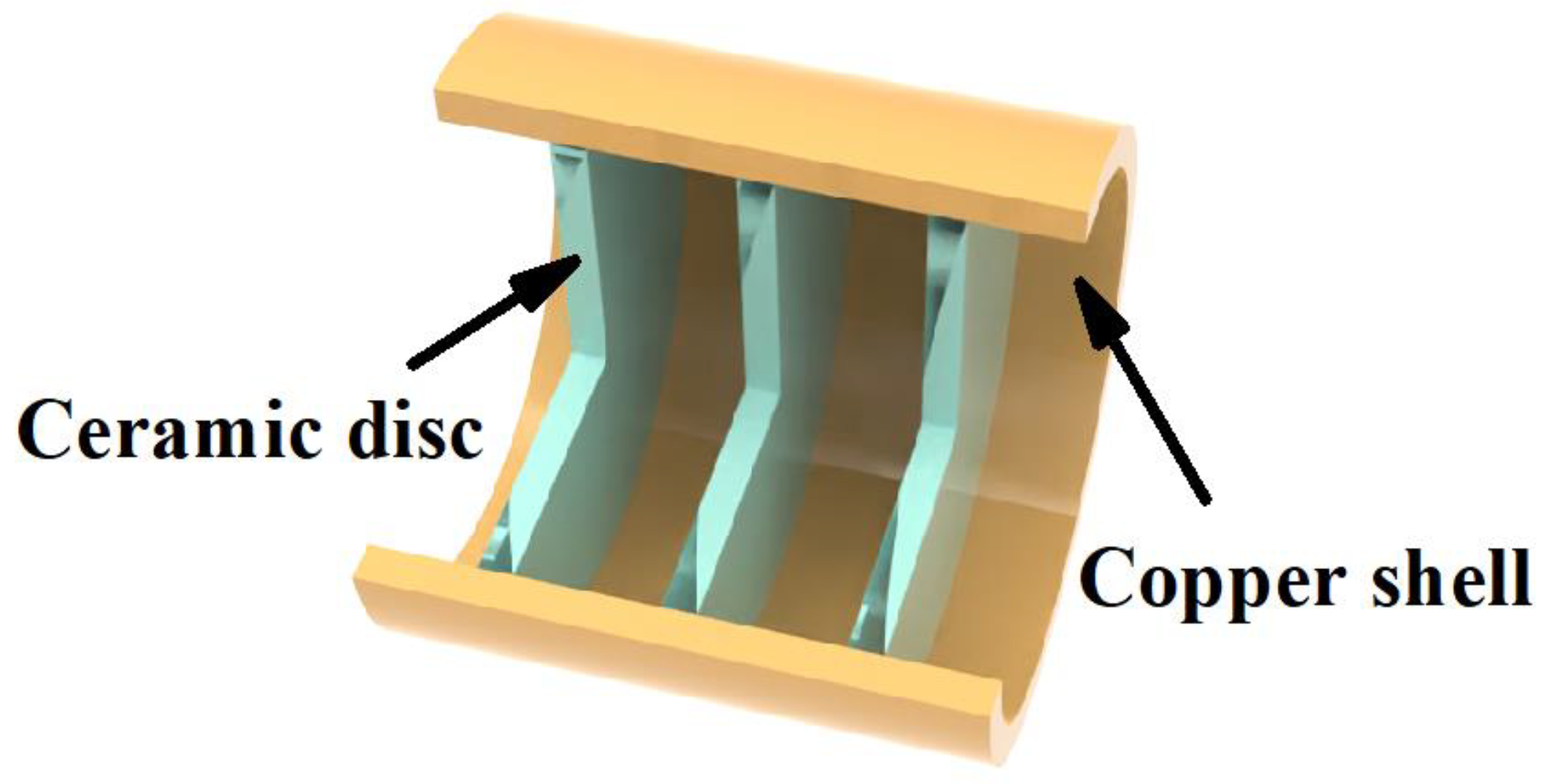Theoretical Design of a Dual-Band TE01/TE02 Mode Gyrotron Traveling Wave Tube
Abstract
:1. Introduction
2. Basic Theoretical Analysis of the Dual-Band Gyro-TWT
3. The Key Component Design of the Dual-Band Gyro-TWT
3.1. Beam–Wave Interaction Circuit and PIC Simulation
3.2. Scheme of the Dual-State Triode MIG
3.3. Dual-Mode Input Coupler with Coaxial Cavity
3.4. Output System
3.5. Discussion
4. Conclusions
Author Contributions
Funding
Data Availability Statement
Conflicts of Interest
References
- Chu, K.R. The electron cyclotron maser. Rev. Mod. Phys. 2004, 76, 489. [Google Scholar] [CrossRef]
- Booske, J.H.; Dobbs, R.J.; Joye, C.D.; Kory, C.L.; Neil, G.R.; Park, G.; Park, J.; Temkin, R.J. Vacuum Electronic High Power Terahertz Sources. IEEE Trans. Terahertz Sci. Technol. 2011, 1, 54–75. [Google Scholar] [CrossRef]
- Nusinovich, G.S.; Thumm, M.K.A.; Petelin, M.I. The Gyrotron at 50: Historical Overview. J. Infrared Millim. Terahertz Waves 2014, 35, 325–381. [Google Scholar] [CrossRef]
- Sabchevski, S.; Glyavin, M.; Mitsudo, S.; Tatematsu, Y.; Idehara, T. Novel and Emerging Applications of the Gyrotrons Worldwide: Current Status and Prospects. J. Infrared Millim. Terahertz Waves 2021, 42, 715–741. [Google Scholar] [CrossRef]
- Samsonov, S.V.; Denisov, G.G.; Gachev, I.G.; Bogdashov, A.A. CW Operation of a W-band High-Gain Helical-Waveguide Gyrotron Traveling-Wave Tube. IEEE Electr. Device Lett. 2020, 41, 773–776. [Google Scholar] [CrossRef]
- Zeng, X.; Du, C.; Li, A.; Gao, S.; Wang, Z.; Zhang, Y.; Zi, Z.; Feng, J. Design and Preliminary Experiment of W-Band Broadband TE02 Mode Gyro-TWT. Electronics 2021, 10, 1950. [Google Scholar] [CrossRef]
- Joye, C.D.; Shapiro, M.A.; Sirigiri, J.R.; Temkin, R.J. Demonstration of a 140-GHz 1-kW Confocal Gyro-Traveling-Wave Amplifier. IEEE Trans. Electron. Dev. 2009, 56, 818–827. [Google Scholar] [CrossRef] [PubMed] [Green Version]
- Nanni, E.A.; Lewis, S.M.; Shapiro, M.A.; Griffin, R.G.; Temkin, R.J. Photonic-Band-Gap Traveling-Wave Gyrotron Amplifier. Phys. Rev. Lett. 2013, 111, 235101. [Google Scholar] [CrossRef] [PubMed] [Green Version]
- Liu, G.; Cao, Y.; Wang, Y.; Jiang, W.; Wang, W.; Wang, J.; Luo, Y. Design and Cold Test of a G-Band 10-kW-Level Pulse TE01-Mode Gyrotron Traveling-Wave Tube. IEEE Trans. Electron. Dev. 2022, 69, 2668–2674. [Google Scholar] [CrossRef]
- Marek, A.; Feuerstein, L.; Illy, S.; Thumm, M.; Wu, C.; Jelonnek, J. New Type of Sub-THz Frequency-Doubling Gyro-TWT With Helically Corrugated Circuit. IEEE Electr. Device Lett. 2022, 43, 1347–1350. [Google Scholar] [CrossRef]
- Hung, C. High-power, stable Ka/V dual-band gyrotron traveling-wave tube amplifier. Appl. Phys. Lett. 2012, 100, 203502. [Google Scholar] [CrossRef]
- Tang, Y.; Luo, Y.; Xu, Y.; Yan, R.; Jiang, W.; Zheng, Y. Design of a Novel Dual-Band Gyro-TWT. IEEE Trans. Electron. Dev. 2014, 61, 3858–3863. [Google Scholar] [CrossRef]
- Dong, K.; Luo, Y.; Jiang, W.; Fu, H.; Wang, S. Magnetron Injection Gun Design for Multifrequency Band Operations. IEEE Trans. Electron. Dev. 2016, 63, 3719–3724. [Google Scholar] [CrossRef]
- Wang, X.; Gao, D.; Wang, Y.; Zhang, F. Novel double-band input coupler for gyroklystron and gyro-TWT. AIP Adv. 2021, 11, 45019. [Google Scholar] [CrossRef]
- Ma, M.; Zhao, Q.; Mo, K.; Zheng, S.; Peng, L.; Lv, Y.; Feng, J. Design of a Dual-Mode Input Structure for K/Ka-Band Gyrotron TWT. Electronics 2022, 11, 432. [Google Scholar] [CrossRef]













| ID | Type of Gyro-TWT | Frequency (GHz) | Power (kW) | Efficiency (%) | Gain (dB) | Bandwidth (GHz) |
|---|---|---|---|---|---|---|
| Ref. [5] | helically corrugated circuit | 96 | 3 kW (CW) | 15 | 54 | 2.5 |
| Ref. [6] | periodic-dielectric-loaded circuit | 93 | >60 | >10.06 | 32 | 8 |
| Ref. [7] | confocal waveguide circuit | 140 | 0.82 | 0.8 | 34 | 0.8 |
| Ref. [8] | photonic-band-gap circuit | 250 | 0.045 | 0.43 | 38 | 8 |
| Ref. [9] | lossy circuit | 220 | >10 (simulation) | >5.7 | >60 | 18 |
| Ref. [10] | helically corrugated circuit (frequency doubler) | 263 | 0.25 (simulation) | 2.5 | >40 | 17.5 |
| Ref. [11] | lossy circuit | Ka/V band | 375/150 (simulation) | 26.7/10.7 | 71/35 | 3.8/1.7 |
| Ref. [12] | lossy circuit | Ku/Ka band | 238/158 (simulation) | 30.9/25.1 | 45.5/50.4 | 1.5/2.5 |
| Quantity | K-Band | Ka-Band |
|---|---|---|
| Operating mode | TE01 | TE02 |
| Beam voltage () | 60 kV | |
| Beam current () | 4.5 A | 4 A |
| Velocity ratio () | 1.2 | 1 |
| Operating magnetic field () | 0.68 Tesla | 1.25 Tesla |
| Waveguide radius () | 10.1 mm | |
| Dielectric thickness | 1.5 mm | |
| Guiding center radius () | 0.48 | 0.2625 |
| Unloaded section length | 48 mm | |
| Total circuit length | 425 mm | |
| Quantity | K-Band | Ka-Band |
|---|---|---|
| Cathode emitter radius () | 12.21 mm | 6.6 mm |
| Cathode magnetic field () | 0.103 Tesla | 0.197 Tesla |
| Magnetic compression ratio () | 6.6 | 6.35 |
| Cathode voltage () | −60 kV | |
| Modulating anode voltage () | −28 kV | −17 kV |
| Length of emitting surface () | 1.15 mm | 1.04 mm |
| Velocity ratio () | 1.2 | 1 |
| Beam current () | 4.5 A | 4 A |
| Axial velocity spread () | <5% | |
| Key Component | Operating Frequency Range | Transmission Coefficient | Reflection Coefficient | |
|---|---|---|---|---|
| K-Band (TE01) | Ka-Band (TE02) | |||
| Beam–wave interaction circuit (Figure 7) | 18.5–19.5 GHz | 33.6–35.6 GHz | - | - |
| Dual-mode input coupler (Figure 10) | 18.5–20.5 GHz | 33.6–35.5 GHz | >−3 dB | <−10dB/<−15 dB |
| Dolph–Chebychev gradual waveguide (Figure 11) | >18.3 GHz | >33.3 GHz | >−0.5 dB | <−20 dB/<−30 dB |
| Three-disk output window (Figure 13) | 17–20.2 GHz | 33.5–36 GHz | >−2.5 dB | <−10 dB/<−15 dB |
| ID | Frequency (GHz) | Power (kW) | Efficiency (%) | Gain (dB) | −3 dB Bandwidth (GHz) |
|---|---|---|---|---|---|
| Ref. [11] | Ka/V band | 375/150 | 26.7/10.7 | 71/35 | 3.8/1.7 |
| Ref. [12] | Ku/Ka band | 238/158 | 30.9/25.1 | 45.5/50.4 | 1.5/2.5 |
| Designed dual-band gyro-TWT | K/Ka band | 87.1/62 | 32.3/25.8 | 42.74/60.76 | 0.7/2 |
Disclaimer/Publisher’s Note: The statements, opinions and data contained in all publications are solely those of the individual author(s) and contributor(s) and not of MDPI and/or the editor(s). MDPI and/or the editor(s) disclaim responsibility for any injury to people or property resulting from any ideas, methods, instructions or products referred to in the content. |
© 2023 by the authors. Licensee MDPI, Basel, Switzerland. This article is an open access article distributed under the terms and conditions of the Creative Commons Attribution (CC BY) license (https://creativecommons.org/licenses/by/4.0/).
Share and Cite
Chen, R.; Zhang, T.; Zhao, Q.; Yu, S. Theoretical Design of a Dual-Band TE01/TE02 Mode Gyrotron Traveling Wave Tube. Electronics 2023, 12, 3282. https://doi.org/10.3390/electronics12153282
Chen R, Zhang T, Zhao Q, Yu S. Theoretical Design of a Dual-Band TE01/TE02 Mode Gyrotron Traveling Wave Tube. Electronics. 2023; 12(15):3282. https://doi.org/10.3390/electronics12153282
Chicago/Turabian StyleChen, Rutai, Tianzhong Zhang, Qixiang Zhao, and Sheng Yu. 2023. "Theoretical Design of a Dual-Band TE01/TE02 Mode Gyrotron Traveling Wave Tube" Electronics 12, no. 15: 3282. https://doi.org/10.3390/electronics12153282




